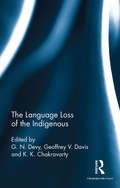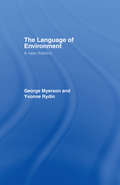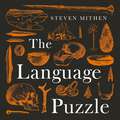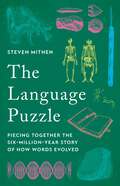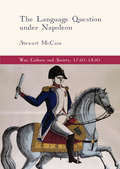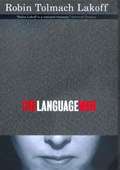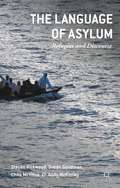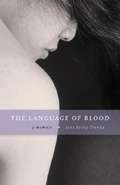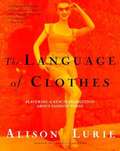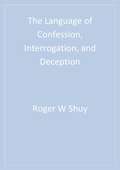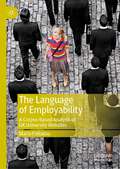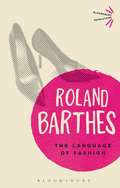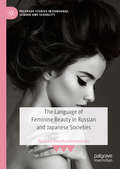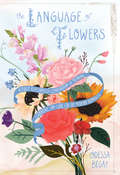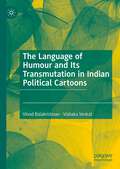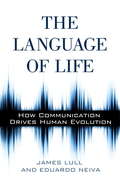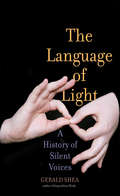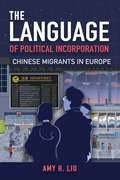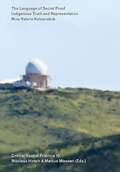- Table View
- List View
The Language Loss of the Indigenous
by G. N. Devy Geoffrey V. Davis K. K. ChakravartyThis volume traces the theme of the loss of language and culture in numerous post-colonial contexts. It establishes that the aphasia imposed on the indigenous is but a visible symptom of a deeper malaise — the mismatch between the symbiotic relation nurtured by the indigenous with their environment and the idea of development put before them as their future. The essays here show how the cultures and the imaginative expressions of indigenous communities all over the world are undergoing a phase of rapid depletion. They unravel the indifference of market forces to diversity and that of the states, unwilling to protect and safeguard these marginalized communities. This book will be useful to scholars and researchers of cultural and literary studies, linguistics, sociology and social anthropology, as well as tribal and indigenous studies.
The Language Myth in Western Culture (Routledge Advances in Communication and Linguistic Theory #2)
by Roy HarrisThe basic claim of this book is that for 2000 years and more the western tradition has relied on two very dubious assumptions about human communication: that each national language is a unique code and that linguistic communication consists in the utilization of such codes to transfer messages from mind to mind.
The Language Of Environment: A New Rhetoric
by Yvonne Rydin George MyersonFirst published in 1996. Routledge is an imprint of Taylor & Francis, an informa company.
The Language Puzzle: How We Talked Our Way out of the Stone Age
by Steven MithenThe relationship between language, thought and culture is of concern to anyone with an interest in what it means to be human.The Language Puzzle explains how the invention of words at 1.6 million years ago began the evolution of human language from the ape-like calls of our earliest ancestors to our capabilities of today, with over 6000 languages in the world and each of us knowing over 50,000 words.Drawing on the latest discoveries in archaeology, linguistics, psychology, and genetics, Steven Mithen reconstructs the steps by which language evolved; he explains how it transformed the nature of thought and culture, and how we talked our way out of the Stone Age into the world of farming and swiftly into today's Digital Age.While this radical new work is not shy to reject outdated ideas about language, it builds bridges between disciplines to forge a new synthesis for the evolution of language that will find widespread acceptance as a new standard account for how humanity began.
The Language Puzzle: Piecing Together the Six-Million-Year Story of How Words Evolved
by Steven MithenA top scholar reveals the most complete picture to date of how early human speech led to the languages we use today The emergence of language began with the apelike calls of our earliest ancestors. Today, the world is home to thousands of complex languages. Yet exactly how, when, and why this evolution occurred has been one of the most enduring—and contentiously debated—questions in science. In The Language Puzzle, renowned archaeologist Steven Mithen puts forward a groundbreaking new account of the origins of language. Scientists have gained new insights into the first humans of 2.8 million years ago, and how numerous species flourished but only one, Homo sapiens, survives today. Drawing from this work and synthesizing research across archaeology, psychology, linguistics, genetics, neuroscience, and more, Mithen details a step-by-step explanation of how our human ancestors transitioned from apelike calls to words, and from words to language as we use it today. He explores how language shaped our cognition and vice versa; how metaphor advanced Homo sapiens&’ ability to formulate abstract concepts, develop agriculture, and—ultimately—shape the world. The result is a master narrative that builds bridges between disciplines, stuns with its breadth and depth, and spans millennia of societal development. Deeply researched and brilliantly told, The Language Puzzle marks a seminal understanding of the evolution of language.
The Language Question under Napoleon
by Stewart McCainThis book offers a new perspective on the cultural politics of the Napoleonic Empire by exploring the issue of language within four pivotal institutions - the school, the army, the courtroom and the church. Based on wide-ranging research in archival and published sources, Stewart McCain demonstrates that the Napoleonic State was in reality fractured by disagreements over how best to govern a population characterized by enormous linguistic diversity. Napoleonic officials were not simply cultural imperialists; many acted as culture-brokers, emphasizing their familiarity with the local language to secure employment with the state, and pointing to linguistic and cultural particularism to justify departures from which what others might have considered desirable practice by the regime. This book will be of interest to scholars of the Napoleonic Empire, and of European state-building and nationalisms.
The Language War
by Robin Tolmach LakoffAre there natural boundaries to our field? How do we differ (if we do) from rhetoricians, literary critics, psychoanalysts, appellate courts, political spin doctors, and others who, theoretically and practically, determine what language means or accomplishes?
The Language and Style of Film Criticism
by Alex Clayton Andrew KlevanThe Language and Style of Film Criticism brings together original essays from an international range of academics and film critics highlighting the achievements, complexities and potential of film criticism. In recent years, in contrast to the theoretical, historical and cultural study of film, film criticism has been relatively marginalised, especially within the academy. This book highlights the distinctiveness of film criticism and addresses ways in which it can take a more central place within the academy and develop in dynamic ways outside it. The Language and Style of Film Criticism is essential reading for academics, teachers, students and journalists who wish to understand and appreciate the language and style of film criticism.
The Language of Angels: A Story About the Reinvention of Hebrew
by Richard Michelson2018 Sydney Taylor Book Award2017 National Jewish Book AwardIn 1885, few Jews in Israel used the holy language of their ancestors, and Hebrew was in danger of being lost—until Ben Zion and his father got involved. Through the help of his father and a community of children, Ben modernized the ancient language, creating a lexicon of new, modern words to bring Hebrew back into common usage. Historically influenced dialogue, engaging characters, and colorful art offer a linguistic journey about how language develops and how one person's perseverance can make a real difference.Influenced by illuminated manuscripts, Karla Gudeon&’s illustrations bring Ben Zion—and the rebirth of Hebrew—to life.A compelling emotional journey — Publisher's WeeklyA lively introduction to the work of a Hebrew language scholar and lover—and his family — Kirkus ReviewsA perfect resource for religious school collections and public library language shelves — BooklistHebrew teachers and students in Jewish schools will welcome this gorgeous new picture book about how the language developed and the impact of one person's perseverance on an entire people — School Library Journal
The Language of Art and Artists (Palgrave Advances in Language and Linguistics)
by Darryl HockingThis book brings together the research of leading scholars who explore the complex interplay between language and art. Employing a diversity of methods—including systemic functional linguistics, corpus analysis, multimodal analysis, genre analysis, discourse analysis, and cognitive linguistics—this edited collection offers fresh perspectives on the role of textual practices in shaping artistic production, interpretation, and engagement across a range of cultural and institutional contexts. The chapters examine a wide range of written and spoken texts, including artists&’ statements, art reviews, painting titles, museum press releases, artists&’ websites, guided tours, audio descriptions, and artist talks. This timely volume is relevant for students, teachers, and researchers in language and applied linguistics, discourse analysis and visual arts, as well as those in the areas of art theory and curatorial studies. It will also appeal to academic literacies and ESP (English for Specific Purposes) practitioners supporting visual arts students worldwide.
The Language of Asylum: Refugees And Discourse
by Simon Goodman Steve Kirkwood Chris McVittie Andy McKinlayThe early part of the 21st century has been marked by widespread social upheaval and geographical displacement of people. This book examines how refugees, asylum-seekers, locals and professional refugee workers make sense of asylum and refuge in the context of current UK asylum policies.
The Language of Blood
by Jane Jeong TrenkaAn adoptee's search for her identity takes her from Minnesota to Korean and back as she seeks to resolve the dualities that have long defined her life: Korean-born, American-raised, never fully belonging to either culture. This evocative memoir explores the myriad facets of personal and cultural identity.
The Language of Clothes
by Alison Lurie Doris PalcaThe classic book about the clothes we wear and what they say about us. Even before we speak to someone in a meeting, at a party, or on the street, our clothes often express important information (or misinformation) about our occupation, origin, personality, opinions, and tastes. And we pay close attention to how others dress as well; though we may not be able to put what we observe into words, we unconsciously register the information, so that when we meet and converse we have already spoken to one another in a universal tongue. Alison Lurie, the Pulitzer Prize-winning novelist, is our savvy guide and interpreter on this tour through the history of fashion. She provides fascinating insights into how changing sex roles, political upheavals, and class structure have influenced costume. Whether she is describing the enormous amount of clothing worn by early Victorian women or illuminating the significance of the long robes worn by aging men throughout history to connote eminence, her analysis is playful, clever, and always on target.
The Language of Confession, Interrogation, and Deception (Empirical Linguistics)
by Roger W. ShuyUsing a linguistic point of view, The Language of Confession, Interrogation, and Deception is a practical explanation of how confessions work, written by the "father of forensic linguistics", Roger W. Shuy. Using his 1993 benchmark work, Language Crimes as his model, Shuy examines criminal confessions, the interrogations that elicit them, and the deceptive language that plays a role in the confession event. He presents transcripts from numerous interrogations and analyzes how language is used, how constitutional rights are not protected, consistency and truthfulness, suggestibility, written confessions, as well as unvalidated confessions. He concludes the volume with explicit advice on how to conduct interrogations that will yield credible evidence. A landmark volume with cross-disciplinary applications, The Language of Confession, Interrogation, and Deception is useful for professionals and academics in linguistics, forensic linguistics, criminal justice, communication, and interpersonal violence.
The Language of Employability: A Corpus-Based Analysis of UK University Websites
by Maria FotiadouThis book employs a corpus-based Critical Discourse Analysis (CDA) methodology to analyse the language used by university careers services in the UK. Drawing on a corpus which includes the public-facing websites of careers services from 24 Russell Group and 34 Post-92 universities, the author highlights some of the potentially problematic 'common-sense' views and ideas that are currently promoted to students using these services. She argues that the language used by university websites promotes neoliberal ideology and encourages the denaturalisation of such language. This book will be of interest to linguists, sociologists, education scholars, and scholars who are otherwise interested in the notion of employability.
The Language of Fashion (Bloomsbury revelations)
by Roland BarthesBarthes' essays here range from the history of clothing to the cultural importance of Coco Chanel, from Hippy style in Morocco to the figure of the dandy, from color in fashion to the power of jewellery. Barthes' acute analysis and constant questioning make this book an essential read for anyone seeking to understand the cultural power of fashion.
The Language of Feminine Beauty in Russian and Japanese Societies (Palgrave Studies in Language, Gender and Sexuality)
by Natalia KonstantinovskaiaThis book conducts a cross-linguistic and cross-cultural study of 'women’s language' as it pertains to feminine beauty. It examines the ideological constructs of beauty and femininity in the cultures of Japan and Russia, as embodied through televised beauty ads, and relates them to the real-world language practices of Japanese and Russian women. The author traces the reciprocal connection between women’s real and imagined language in the construction of ideals of beauty and femininity, revealing the complex ways women respond to ideological expectations regarding language use: assimilating, transforming, and subverting ideologized language and the assumptions implicit in it. She also demonstrates ways in which women alter the texture of language by appropriating 'masculine' language for their own purposes, shifting the meaning and correlates of linguistic items and structures. This book will be of interest to students and scholars of sociolinguistics, language and gender, cultural and media studies, and Russian and Japanese culture.
The Language of Flowers: A Fully Illustrated Compendium of Meaning, Literature, and Lore for the Modern Romantic
by Odessa BegayWith gorgeous full-color illustrations, ornate decorative elements, lettering in metallic ink, and engaging text, The Language of Flowers: A Fully Illustrated Compendium of Meaning, Literature, and Lore for the Modern Romantic is a treasure for flower lovers. A sumptuous, contemporary anthology of 50 of the world's most storied and popular flowers, each of its entries offers insight to the meaning associated with the flower, and is a fascinating mix of foklore, classic mythology, literature, botanical information and popular culture. Following an introduction that provides a short history of the language of flowers, a fad which reached its peak during the reign of Queen Victoria, each uniquely illustrated and designed entry is an enjoyable read full of history and little-known facts. Here is the story of Tulipmania; how the pansy got its "face," and why the most particular pollination process of a certain orchid has made the vanilla bean a very dear commodity. You'll also dicover how Christian Dior's passion for lily of the valley inspired his classic perfume Diorissimo and its extraordinary bottle; why Oscar Wilde had a penchant for wearing green carnations in his lapel; and how Greeks and Romans believed snapdragons could ward off witchcraft, so they planted them at entryways to their homes. With more than a dozen two-page paintings evoking the romance of noteworthy Victorian gardens and symbolic bouquets, a cross-referenced index of flowers and meanings, and suggestions for further reading, this book is a must for lovers of floriology and Victoriana.
The Language of Humour and Its Transmutation in Indian Political Cartoons
by Vinod Balakrishnan Vishaka VenkatThis book develops a model to examine the language of humour, which is multimodal and accounts for the possibility of transmutation of humour as it is performed through editorial cartoons. By transmutation is meant the transition in the language of humour when it crosses its own boundaries to provoke unprecedented reactions resulting in offensiveness, disappointment or hurt sentiment. The transmutability about the language of humour points to its inherently diabolical nature which manifests in the performance of controversial cartoons. The model is built by borrowing theoretical cues from Roman Jakobson, Roland Barthes, George Lakoff and Mark Johnson. The integrated model, then, is developed to examine the cartoons which were recommended for deletion by the Thorat Committee, following a cartoon controversy in India. Through the cartoon analysis, the model discerns the significance of context and temporality in determining the impact of humour. It also examines how the ethics of humour; the blurred lines of political correctness and incorrectness are dictated by the political atmosphere and the power dynamics.
The Language of Life
by James LullCommunication in its most basic form--the sending of signals and exchange of messages within and between organisms--is the heart of evolution. From the earliest life-forms to Homo sapiens, the great chain of communication drives the evolutionary process and is the indispensable component of human culture. That is the central message of this unique perspective on both the biological evolution of life and the human development of culture. The book explores the totality of communication processes that create and sustain biological equilibrium and social stability. The authors argue that this ubiquitous connectivity is the elemental unity of life. Introducing a new subdiscipline--evolutionary communication--the authors analyze the core domains of life--sheer survival, sex, culture, morality, religion, and technological change--as communications phenomena. What emerges from their analysis is a brilliant interpretation of life interconnected through communication from the basic molecular level to the most sophisticated manifestations of culture. Challenging the boundaries of conventional approaches to cultural analysis, this is an original and engaging view of evolution and an encouraging prognosis for our collective future.
The Language of Light: A History of Silent Voices
by Gerald SheaA comprehensive history of deafness, signed languages, and the unresolved struggles of the Deaf to be taught in their unspoken tongue Partially deaf due to a childhood illness, Gerald Shea is no stranger to the search for communicative grace and clarity. In this eloquent and thoroughly researched book, he uncovers the centuries-long struggle of the Deaf to be taught in sign language—the only language that renders them complete, fully communicative human beings. Shea explores the history of the deeply biased attitudes toward the Deaf in Europe and America, which illogically forced them to be taught in a language they could neither hear nor speak. As even A.G. Bell, a fervent oralist, admitted, sign language is "the quickest method of reaching the mind of a deaf child." Shea’s research exposes a persistent but misguided determination among hearing educators to teach the Deaf orally, making the very faculty they lacked the principal instrument of their instruction. To forbid their education in sign language—the “language of light”—is to deny the Deaf their human rights, he concludes.
The Language of New Media (Leonardo)
by Lev ManovichA stimulating, eclectic accountof new media that finds its origins in old media, particularly the cinema.In this book Lev Manovich offers the first systematic and rigorous theory of new media. He places new media within the histories of visual and media cultures of the last few centuries. He discusses new media's reliance on conventions of old media, such as the rectangular frame and mobile camera, and shows how new media works create the illusion of reality, address the viewer, and represent space. He also analyzes categories and forms unique to new media, such as interface and database.Manovich uses concepts from film theory, art history, literary theory, and computer science and also develops new theoretical constructs, such as cultural interface, spatial montage, and cinegratography. The theory and history of cinema play a particularly important role in the book. Among other topics, Manovich discusses parallels between the histories of cinema and of new media, digital cinema, screen and montage in cinema and in new media, and historical ties between avant-garde film and new media.
The Language of Political Incorporation: Chinese Migrants in Europe (Asian American History And Cultu Ser. #225)
by Amy LiuIn this groundbreaking study, The Language of Political Incorporation, Amy Liu focuses on Chinese migrants in Central-Eastern Europe and their varying levels of political incorporation in the local community. She examines the linguistic diversity of migrant networks, finding institutional trust and civic engagement depend not on national identity, but on the network’s linguistic diversity—namely, whether the operating language is a migrant’s mother tongue or a lingua franca. The Language of Political Incorporation uses original survey data to assess when the Chinese engage positively with the authorities and when they become civic minded. The results are surprising. In Hungary, the Chinese community has experienced high levels of political incorporation in part because they have not been targeted by anti-immigrant rhetoric and policies. In contrast, migrants in Romania sought the assistance of the Chinese embassy to fight an effort to collect back taxes. Liu also compares the Chinese experiences in Central-Eastern Europe with those of Muslims in the region, as well as how the Chinese are treated in Western Europe. Additionally, she considers how the local communities perceive the Chinese. The Language of Political Incorporation concludes by offering best practices for how governments can help migrants become more trusting of—and have greater involvement with—locals in their host countries. Ultimately, Liu demonstrates the importance of linguistic networks for the incorporation of immigrants.
The Language of Political Incorporation: Chinese Migrants in Europe (Asian American History And Cultu Ser. #225)
by Amy LiuIn this groundbreaking study, The Language of Political Incorporation, Amy Liu focuses on Chinese migrants in Central-Eastern Europe and their varying levels of political incorporation in the local community. She examines the linguistic diversity of migrant networks, finding institutional trust and civic engagement depend not on national identity, but on the network’s linguistic diversity—namely, whether the operating language is a migrant’s mother tongue or a lingua franca. The Language of Political Incorporation uses original survey data to assess when the Chinese engage positively with the authorities and when they become civic minded. The results are surprising. In Hungary, the Chinese community has experienced high levels of political incorporation in part because they have not been targeted by anti-immigrant rhetoric and policies. In contrast, migrants in Romania sought the assistance of the Chinese embassy to fight an effort to collect back taxes. Liu also compares the Chinese experiences in Central-Eastern Europe with those of Muslims in the region, as well as how the Chinese are treated in Western Europe. Additionally, she considers how the local communities perceive the Chinese. The Language of Political Incorporation concludes by offering best practices for how governments can help migrants become more trusting of—and have greater involvement with—locals in their host countries. Ultimately, Liu demonstrates the importance of linguistic networks for the incorporation of immigrants.
The Language of Secret Proof: Indigenous Truth and Representation
by Nina Valerie KolowratnikNew spatial notational systems for protecting and regaining Indigenous lands in the United States. In The Language of Secret Proof, Nina Valerie Kolowratnik challenges the conditions under which Indigenous rights to protect and regain traditional lands are currently negotiated in United States legal frameworks. This tenth volume in the Critical Spatial Practice series responds to the urgent need for alternative modes of evidentiary production by introducing an innovative system of architectural drawing and notation. Kolowratnik focuses on the double bind in which Native Pueblo communities in the United States find themselves when they become involved in a legal effort to reclaim and protect ancestral lands; the process of producing evidence runs counter to their structural organization around oral history and cultural secrecy. The spatial notational systems developed by Kolowratnik with Hemish tribal members from northern New Mexico and presented in this volume are an attempt to produce evidentiary documentation that speaks Native truths while respecting demands on secrecy. These systems also attempt to instigate a dialogue where there currently is none, working to deconstruct the fixed opposition between secrecy and disclosure within Western legal systems.
